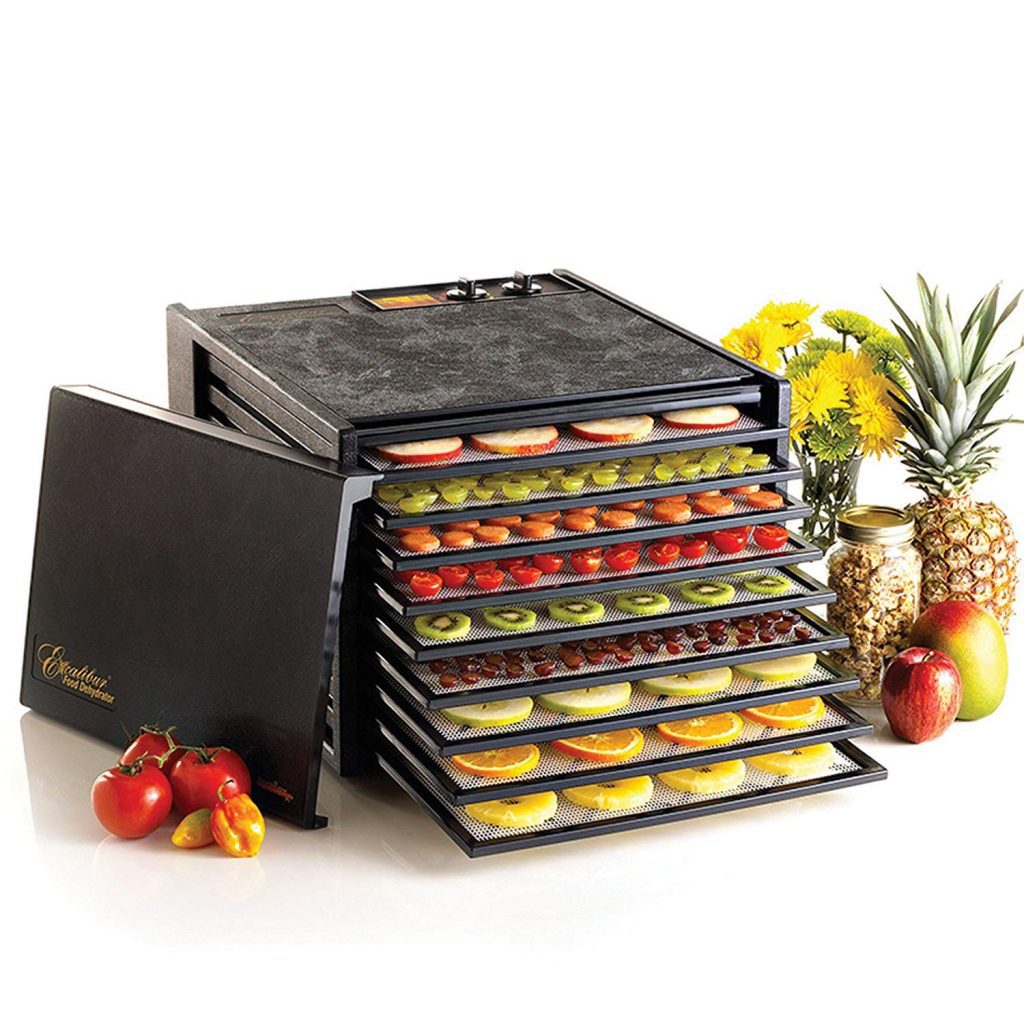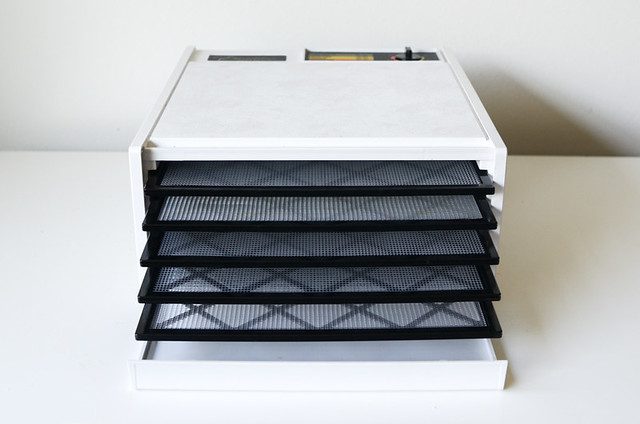We have all tried food that has been dehydrated, like fruits, granola, chips, or jerkies. But there is a good chance that we don’t all clearly understand how that slice of mango in our hands got from soft, juicy, and messy to chewy and clasped within our grip without the need for a napkin. After a quick google search, you’ll find out that the magic behind the scenes is a dehydrator, but how does a dehydrator work?
We were curious upon first encountering/hearing about a dehydrator too. So we explored and researched deep into this transformative machine to discover many answers and provide you with explanations.
How Does a Dehydrator Work?
So, how does a dehydrator work? A dehydrator is an electrical machine that removes the moisture content of whatever is inside. It is comprised of trays, heating elements, vents, and a fan for circulation. The dehydrator’s heating element raises the temperature inside the machine, the fan evenly circulates the heat and removes the moisture, while the trays hold the food you wish to dehydrate. Of course, many details go into the actual use of a dehydrator. You can’t just cut your food up, throw them into the machine, close the door, and say “work!” Those details can be intimidating too. Dehydrators have a scale of temperature to use, and you need to learn which temperatures are most appropriate for each food. There are timetables for how to get the perfect dehydration of your specific food. Then, there are plenty of dehydration machines out there on the market, so you need to know what to look for and what you want to avoid while on the prowl. Luckily our interest has led us to some great discoveries, and we are happy to share them in the hopes of steering you in the right direction!
Heating
The heat of the dehydrator pulls the moisture from the contents inside. The machine achieves this in its own unique way by applying low temperatures and long cooking times. This process is the ultimate moisture removal process as it preserves the nutrients and flavors of the food. High-heat cooking will often zap the nutritious value of food and char the potential flavors of the food itself.
So one of the main reasons we use a dehydrator is because we can get delicious and tasty treats from the technology. But another main reason is that it works terrifically to preserve the food that we place inside. The heat’s ability to remove the moisture from the content inside the dehydrator keeps bacteria, yeasts, and molds from growing on the food. All that stuff that makes our food go bad needs the moisture of the food to survive.
Those bananas on the counter can live for months longer thanks to this amazing application.
Furthermore, the heat of a dehydrator works great on herbs and spices. How many times have you had to quickly throw your fresh herbs out because they got wet soggy and smelling bad? With high moisture content, our fresh herbs and spices are very prone to attracting mold and bacteria. Using a dehydrator to dry our herbs and spices gives us longer-lasting use for our bountiful harvests or purchases.
When you ask, “How does a dehydrator work?” the heating element plays a huge role, but it isn’t the only aspect. When the heat removes the moisture from the content, within the machine, that moist air is going to hang around, the machine, and become reabsorbed by the material; Think about steaming veggies. So there is another significant component at work with dehydrators, air circulation.
Air Circulation
Air circulation is going to take the moist air that the heating elements pull from the food inside and work with the vents on the dehydrator to push it outside the machine. This keeps the food from reabsorbing the moisture it just lost. But on top of removing the moist air through the vents, the dehydrator also pulls the dry air from outside of the machine inside to make sure the content is in a moisture-free environment and undergoing the most thorough process of dehydration.
On top of maintaining a space of dry air within the dehydrator, the fans that create the air circulation also make sure that the heat within the machine is evenly distributed to every item inside. A quality machine isn’t going to super dry a few things and leave a couple of other items still wet inside. A quality machine is going to make a batch of equally dehydrated and superb treats.
There are two styles of air circulation that a dehydrator uses. Understanding ”How does a dehydrator work?” means understanding the two available options for excellent air circulation and in turn dehydration.
Horizontal Air Movement
Horizontal air movement is great because it eliminates the need to stir around and rotate the trays inside. A dehydrator with horizontal air movement means that there is a fan in the back of the machine and it blows towards the door you open the machine with. The air blows across all the items on each tray and dries each thing equally.
Vertical Air Movement
These dehydrators come in two different ways, the fan can either be at the top of the machine or it can be at the bottom. Heat rises, so typically with a top-side fan, the food on the bottom will become much drier than the food on the top. The food on the top will have a harder time receiving the heat, which is what we rely on to pull the moisture out. However, when the fan is at the bottom, there is a good chance that food will drip and drop down and making cleaning a problematic process. If your machine has a fan at the bottom, your food will dry much more evenly, but you should make sure the trays are drip-proof.
What Kind of Food Can You Dehydrate?
You can dehydrate all different types of food, including herbs and spices as well. Some enjoyable ideas include fruits such as mango, pineapple, apples, plums, blueberries, apricots, kiwi, pears, grapes, and cranberries. Some enjoyable veggies include eggplant, asparagus, tomatoes, zucchini, onion, garlic, potatoes, and mushrooms. You can take flowers from the garden, dry them out, and then put them on display as potpourri. This option is excellent because the flowers can stay out for longer. There are a bunch of recipes across the internet and in bookstores that you can use to make some extremely appetizing creations. For example, you can marinate eggplants and mushrooms, dehydrate them, and then enjoy mock meat. You can also throw slices of potatoes in your dehydrator after soaking them and enjoy delicious potato chips! The potential is as endless as your imagination!
History
Dehydrating food has been a part of human culture for thousands of years. Ancient civilizations would take their food and would lay it out, and spread it evenly, so all the food could soak in equal amounts of sunshine.
When you go to other countries such as Indonesia or places in Africa, where these modern technologies aren’t so available, you will probably still see villagers laying out their harvests. They still use the sun to soak out the moisture and dry their food.
Advances in technology have enabled us to remove the potential presence of pollutants, bugs, birds, and other natural disturbances. Dehydrators are safer more advanced methods that you can use on a rainy day too!
Dehydration comes from a humble beginning, and now we can harness the power of those times in a small square-like box right on our kitchen countertops! Take a moment to be grateful for good living in the new century.
Product Comparison Table
[amazon box=”B008OV4FD0, B01M6AZ863, B074P6MGFR,” template=”table”]
Some Industry Leading Dehydrators
Here are the leading dehydrators that you can choose from.
Excalibur 3926TB
[amazon box=”B008OV4FD0″]
If you are looking for an all-around trustworthy dehydrator, look no further than the Excalibur 3926TB. They cost a bit more than competitive models but build meticulously quality machines. You can tell that they are dehydrating enthusiasts that use their own products.
You can find it here:
If you are looking for another great option, that is a bit less expensive and serious, then you will do well with the possibilities from Gourmia.
Gourmia GFD1950 with 9 trays
[amazon box=”B01M6AZ863″]
The first Gourmia option is the GFD1950. They are another high-quality dehydrator that tunes their attention to the details for great results time and time again. This option from Gourmia will yield a bunch of dried foods thanks to their 9-tray system design.
You can find it here:
Gourmia GFD1950 with 6 trays
[amazon box=”B074P6MGFR”]
Another variation of the Gourmia GFD1950 is one with 6 trays. This machine is the same model as the 9-tray version we mentioned above, capable of the same great results, but it takes up less space by implementing only 6-trays in its design. 6-tray means less dried food per yield. But if that suits your needs fine then this is a fantastic option.
You can find it here:
Conclusion
Hopefully, by now, we have adequately answered your curious question “How does a dehydrator work?”
You should now be well equipped with the info and insight to get you well on your way. So go have some fun utilizing the power of this handy gadget to make all the tasty treats your heart desires, without the stifling intimidation of how this machinery works! And let us know how your experiences go!



